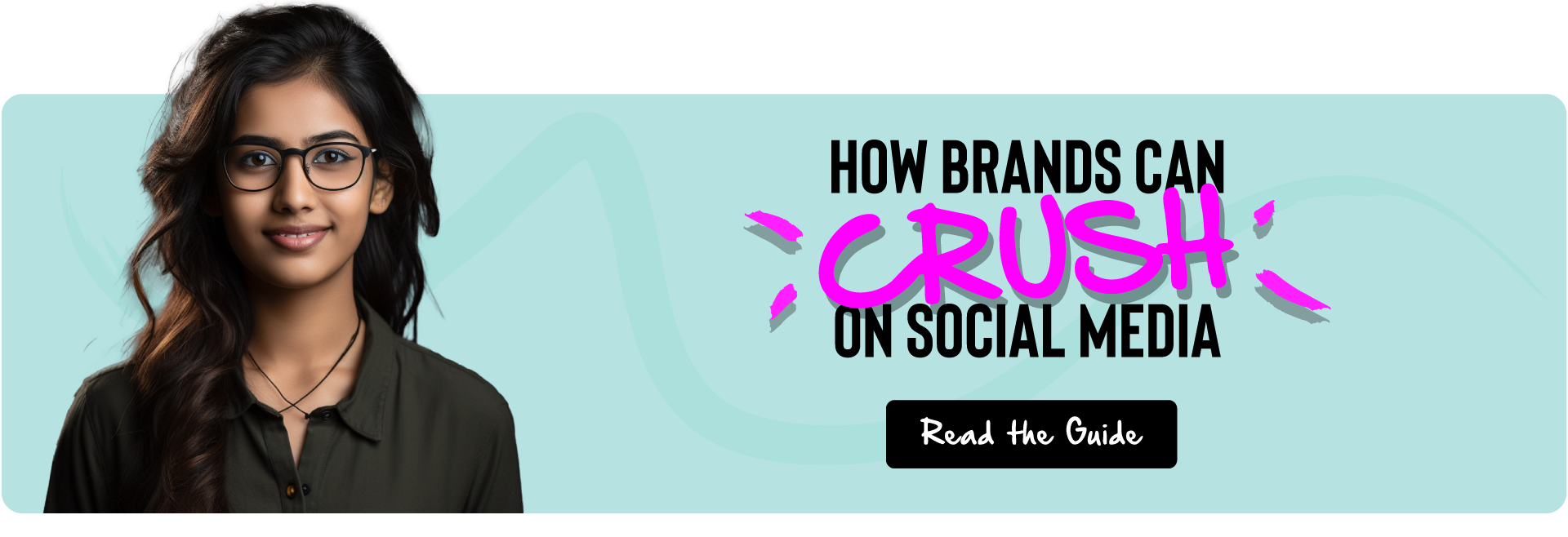How CPG Brands Can Build a Strong Social Media Presence

There are millions upon millions of social posts each day, across a variety of social platforms. You may think that it’s futile to try and stand out. Your post will be a drop in an ocean of content. I’ve certainly had this thought once or twice before. There are accounts that make really amazing content consistently, which is intimidating and daunting to think you can ever compete with them at that level. So it begs the question, is organic social still a viable marketing channel?
I believe it is.
I know this is a broad topic, but I’ll try to give you some high-level things that have worked for me and other brands, specifically in the consumer packaged goods (CPG) space.
In this post, we look at social media as a marketing channel (specifically looking at organic social), how to maintain content generation and a strong social presence.
Is organic social still a viable marketing channel?
Yes!
There are plenty of examples of brands, both large and small, completely changing their company’s trajectory with social media.
But that’s not to say it’s easy, it’s just saying it’s possible.
Social media has a low barrier of entry, meaning, anyone can post at any time, and they do.
So there’s a lot of competition competing for our attention. But social media is different than paid ads in that they aren’t interrupting your entertainment, they are your entertainment. They are usually not inherently trying to sell you something, they are more trying to entertain, educate, or inspire you.
Social profiles that fail treat their posts as another form of advertising – they promote. This is not the intended reason people log onto social media.
So how do you stand out in such a crowded space?
By being authentic (unique, true to yourself, offering perspective), creative (showing something different, being funny, engaging, controversial), and executing well (delivery, execution, editing, promises, payoffs, pacing, visual and verbal hooks, tone, music choice, sound, lighting…) By combining these elements (and there’s a lot), you have a shot of being interesting.
The importance of authenticity and creativity cannot be understated. With so much content being shared every day, it’s essential for brands to be genuine and unique in their approach.
Authenticity builds trust with your audience and sets you apart from competitors who may be more focused on promotional messaging. Share behind-the-scenes glimpses of your brand, showcase your company culture, and engage with your audience in a personal and meaningful way.
Creativity is also key to grabbing attention on social media. Always think outside the box and find creative ways to tell your brand’s story and connect with your audience on a deeper level. The goal is to capture attention and hold attention, and to do that, your post must be interesting. It’s hard to define what interesting looks like, but you should know it when you see it.

What makes content interesting?
I spent .5 seconds looking at the most majestic humpback whale breach on Insta.
I scrolled right past it. Next!
Wow, how desensitized am I to seeing amazing content? Aren’t we all?
It’s going to get even worse once AI video starts filling our feeds with the most spectacular things beyond our imaginations.
It will become common and boring.
So it begs the question(s)…
👉 What is the future of content and social media?
👉 How can brands stand out and gain attention?
I heard the former Head of Social Media at Red Bull say, “A question brands should ask themselves is…
…if you were to remove your product from your posts, what would be left? What is your company actually about?”
This is why branding and storytelling are so important.
I can’t answer the above questions, because it evolves and it’s different for each brand, but I can say that your content needs to be interesting.
A whale breaching on its own isn’t interesting enough.
But, what if we were told a story about a guy who lost it all – fresh off a divorce, he quit his job, sold all his things, and moved to Norway to follow his passion. It has always been his dream to see a whale breach. Insert emotional buildup. Insert whale breach. Insert emotional release.
Isn’t that more interesting already?
Don’t you now want to follow his journey to see what else he sees and how his life turns out? What will he see next? Will he ever find love again?
We become hooked, we become invested, we’ve connected, we subscribe, we like, we comment, we share…
Bring story into your brand and social content, and show emotion.
That’s how you will attract, engage, and delight.
A Social Media Framework for CPG Businesses
Social media has become an indispensable tool for consumer packaged goods (CPG) businesses to connect with their audience, build brand loyalty, and drive sales. However, navigating the ever-evolving landscape of social media can be daunting.
To help CPG businesses leverage the power of social media effectively, we’ve developed a comprehensive framework that outlines key strategies and best practices tailored specifically for this industry.
1. Define your goals
I always start with goals – one of my favourite sayings is, ‘to what end?’ To what end are we doing this? If we cannot come up with a good reason for doing something, perhaps we shouldn’t be doing it.
So defining clear, measurable goals (i.e. S.M.A.R.T. goals) you will know why your doing it, what you hope to get out of it, and how you will know if your goal has been achieved. But, take this with a grain of salt. Not every activity worth doing can be measured.
Perhaps your goals for social media are to:
- Increase brand awareness
- Drive website traffic
- Generate leads
- Boost sales
2. Define your branding
Before diving into content creation, it’s essential to have a clear understanding of your brand’s identity. A question I like to ask is, “What is our social feed about if we cannot talk about our product?”
Once you define clearly what your brand represents, then you can start to ideate on how you want to portray it on social media and the kinds of posts you want to make. I like to use the example of Red Bull, who never showcase their product on their social media. Instead, every post is about some crazy action sports stunt. This approach allows consumers to connect with the brand on a deeper level.
Further to this, you need to understand your audience. Conduct research to understand your target audience’s values and interests. This information will help you create content that resonates with your audience. A lot more can be said here, but to be brief, too often companies think they know their audience based on assumptions, stereotypes, and useless data (demographics). If your interest is piqued by this, contact me and I will tell you more about this.
3. Choose the right platforms
So you know your brand and audience, now it’s time to come up with content ideas, right? Almost.
I would put ‘choose the right platforms’ before the ‘plan your content stage’. The reason why is because the platforms you choose, and how many, will dictate the type of content you make. Each platform is different and therefore you should be making contextually relevant content based on the platform.
So you want to first understand where your audience is (i.e. what platforms they are on), and select social media platforms that align with your goals and target audience.
Focus on a few key platforms that align with your brand and target audience. Platforms like TikTok, Instagram Reels, YouTube Shorts, and LinkedIn can be highly effective for CPG brands, especially those who are leading with a video-first approach. Be sure to tailor your content to each platform’s unique features and audience expectations.
You don’t need to be on every single platform, choose what you can handle. Doing a few channels reasonably well is better than doing five really poorly. Remember, each platform requires an in-depth understanding of the kinds of content / trends are appropriate, which requires time spent on the platform. Further to that, you then need to make contextually appropriate content for that platform that may be different than what you would post on another platform. Each has their own analytics, which takes time to collect, manage, and review. Each platform may have several people commenting, which adds time to reply to.
The point is, each platform adds a lot or workload to manage and maintain, time that you may not have.
4. Develop a social media content strategy
So you know your brand, your audience, and which platforms you want to be on, now it’s time to come up with content ideas! What is a social media content strategy? Is it different than a content strategy?
Yes, they are different. Not every piece of content you create needs to be posted on social media. In the context of this post, we are only looking at content for social media.
A social media content strategy is a plan that outlines how an organization will use social media to achieve its goals. It involves defining the target audience, determining the types of content that will be created and shared on social media platforms, and establishing the frequency and timing of posts. A social media content strategy also includes guidelines for engaging with followers, responding to comments and messages, and measuring the effectiveness of the content in achieving the organization’s objectives on social media.
Your social media content strategy should outline the types of content you will create, how often you will post, and the tone and style of your content. Consider using a mix of content types, including images, videos, and blog posts.
I would then create a content calendar to plan and schedule your posts in advance. This will help you stay organized and ensure a consistent posting schedule.
Here are some of the key considerations:
Content Pillars and Planning
Develop a content strategy based on content pillars, types of content, platforms, and emotional appeal. Plan your content in advance to ensure consistency and relevance. Consider using a framework to organize your content effectively.
Embrace Video Content
Video is king in the world of social media. Focus on creating video content that is engaging, authentic, and informative. Avoid using stock photography or AI-generated videos, as these can come across as impersonal.
Content Creation and Collaboration
Decide who will create your content and how. You can work with content creators, create content in-house, or collaborate with marketing partners. Document your experiences, share behind-the-scenes moments, and aim to educate, entertain, and inspire your audience.
Posting Strategy
Post contextually relevant content that resonates with each platform’s audience. Avoid reposting the same content across all platforms, as this can appear lazy and unengaging. For LinkedIn, consider posting via your personal account rather than your brand account for a more authentic touch.
5. Engage with Your Audience:
Social media is equal parts creating and consuming. Too often brands just post and ghost. This is the equivalent to having a one-way conversation. It’s okay to be social.
Spend some time in the comments, reply, ask questions, listen, build some relationships, slide in some DMs.
Engage with your audience!
6. Monitor and Measure
Each platform will have their own analytics tools you can use to monitor the performance of your posts and campaigns. You can track key metrics such as reach, engagement, and conversions to measure the effectiveness of your social media efforts.
Based on your analytics, you can adjust your social media strategy as needed. Experiment with different types of content, posting times, and messaging to optimize your results.
9. Collaborate with Influencers
One of the best ways to amplify your message is to connect it with another account who has a larger following, but shares the same follower base as you. Consider partnering with influencers in your industry to reach a larger audience and build credibility for your brand. This will most likely be pay-to-play.
10. Stay Up-to-Date
Social media is constantly evolving. Stay informed about the latest trends and updates in social media marketing to ensure your strategy remains effective.
Why You Need to Be on Social Platforms
Social media is a crucial tool for reaching and engaging with consumers
Massive Reach: Social media platforms have billions of active users, allowing brands to reach a vast audience quickly and efficiently.
Targeted Advertising: Social media platforms offer highly targeted advertising options, allowing brands to reach specific demographics, interests, and behaviors, increasing the effectiveness of their marketing efforts.
Direct Communication: Social media allows brands to communicate directly with their audience, fostering a sense of connection and engagement. This direct interaction can lead to increased brand loyalty and customer satisfaction.
Brand Awareness: Social media provides a platform for brands to increase their visibility and awareness. By regularly posting engaging content, brands can increase their visibility and reach new audiences.
Engagement and Feedback: Social media allows brands to engage with their audience in real-time, soliciting feedback, answering questions, and addressing concerns. This two-way communication can help brands better understand their audience and improve their products or services.
Content Distribution: Social media provides a platform for brands to distribute content such as blog posts, videos, and infographics. This can help increase traffic to their website and generate leads.
Competitive Advantage: Having a strong social media presence is essential for staying competitive. Brands that are active on social media are perceived as more modern, trustworthy, and customer-focused.
Building a strong social media presence for CPG brands requires careful planning, creativity, and a deep understanding of your audience. By following these guidelines, you can create a compelling social media strategy that resonates with your target market and drives engagement.
Ready to discuss your social strategy? Connect with us to get started.
Continue reading: So You Want to Be a Growth Hacker?
Related Posts

The Future of the Internet: The Next Evolution After the Internet Dies aka Dead Internet Theory

Jab, Jab, Jab, Right Hook… A Proven Strategy for Social Media Marketing

Are Your Customers ‘Aging Out’?

Fragmented Future: The Rise of the Microbrand

How Skype Fumbled the Biggest Bag… Ever

A New Definition of SaaS: Steve-Jobs-as-a-Strategy
Need help with your marketing activities?
If you’re looking to make a move with your marketing, reach out to us. We are priced fairly, we’re straight shooters, and are the very best at what we do.


